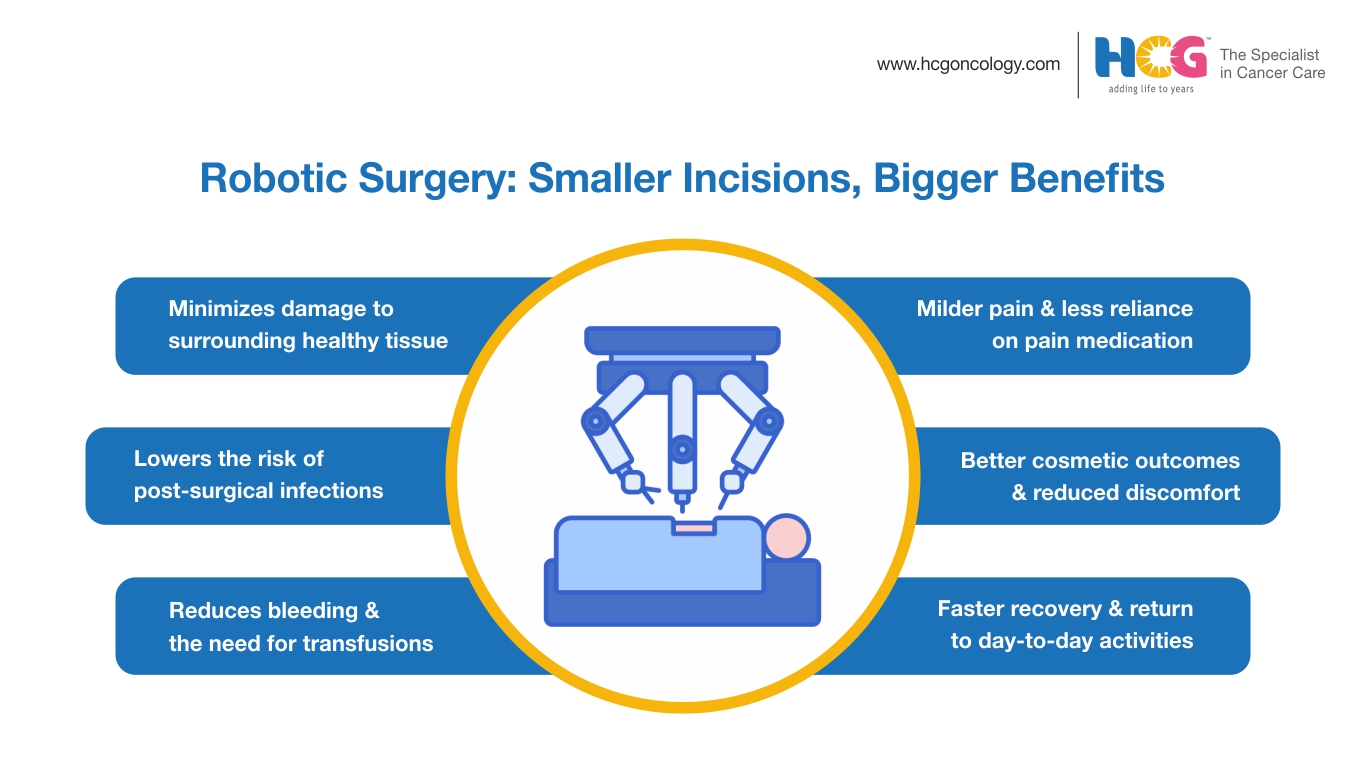
07 Nov, 2025
Feel free to reach out to us.

07 Nov, 2025

This article is medically reviewed by Dr. Dushyant Mandlik, Consultant - Surgical Oncology, HCG Aastha Cancer Centre, Ahmedabad.
Robotic surgery represents a groundbreaking advancement in the surgical management of diseases. It offers a more precise, minimally invasive alternative to traditional surgery.
Surgeons can perform complex operations with enhanced control, flexibility, and accuracy with sophisticated robotic or surgical robots.
The robotic surgical system comprises robotic arms, which carry surgical tools and a camera. These robotic arms are controlled by a surgeon who sits at the surgical console.
Robotic surgery is transforming the field of cancer surgery, as it benefits patients in multiple ways. Some of the key robotic surgery benefits include enhanced precision, fewer treatment-related complications, reduced scarring, and a faster recovery.
At HCG Aastha Cancer Centre, we recommend robotic surgery through the da Vinci Robotic Surgical System for the surgical management of different types of cancer.
The primary benefits of robotic surgery, regardless of the therapeutic domain, are enhanced precision, minimal invasiveness, reduced pain and blood loss, zero to minimal scarring, and swift recovery.
Depending on the organ operated on, robotic surgery may be categorized into the following types:
Certain head and neck cancers can be treated with robotic surgeries. Robotic surgeries are especially beneficial for head and neck cancer patients, as they focus on preserving the aesthetics by causing zero to minimal scarring while also prioritizing effective management of the disease.
Robotic throat surgery, robotic thyroidectomy, and transoral robotic surgery (TORS) for oropharyngeal cancers are some of the most commonly performed robotic head and neck surgeries.
Robotic thoracic surgery is recommended to manage different types of thoracic cancers, namely lung cancer, esophageal cancer, and thymus gland cancer.
The surgeons perform minimally invasive surgery for thoracic cancers by creating a small incision. Patients who undergo minimally invasive lung surgery, such as robotic lobectomy, often report less postoperative pain, reduced discomfort, and quicker recovery times.
Not all patients with gastrointestinal cancers may be candidates for robotic surgery. Various factors, such as the type of GI cancer, its stage and grade, its exact location and shape, the patient’s age and overall condition, and lastly, their preferences, are considered before recommending robotic surgery as a treatment option.
At HCG Aastha, our expert team is equipped to perform robotic surgery for esophageal cancer, stomach cancer, pancreatic cancer, liver cancer, gallbladder cancer, and rectal cancer.
Robotic surgery's minimally invasive and precise nature results in faster recovery, less postoperative pain, and fewer complications.
Some of the advanced procedures performed at HCG Aastha include robotic hepatectomy, robotic cholecystectomy (also known as robotic gallbladder removal or robotic gallbladder surgery), and robotic appendectomy, among others.
Robotic surgery also has a far-reaching effect on the procedure and outcomes of gynecological surgeries. Robotic systems perform gynecological surgeries, such as myomectomy, hysterectomy, and endometriosis.
Advanced robotic systems offer 3D visualization and enhanced dexterity, allowing surgeons to perform more effective and minimally invasive surgeries with reduced recovery time and fertility preservation.
Apart from prostatectomy, robotic surgery also finds its way into performing various other urological procedures, including bladder surgery, pyeloplasty, and kidney surgery. Precision is of utmost importance in these urological surgeries, especially in robotic kidney removal, to avoid damage to the surrounding tissues.
Robotic surgery for kidney cancer involves the removal of the affected kidney. Robotic partial nephrectomy involves the removal of some part of the affected kidney.
Robotic surgery for bladder cancer is a minimally invasive bladder surgery wherein the bladder is removed.
Robotic prostatectomy is a minimally invasive prostate surgery and is one of the most common treatment options for treating prostate cancer. It is also a form of urologic surgery. The robotic system is commonly used for performing prostatectomy. Robotic surgery for prostate cancer is performed through advanced robotic systems, like the da Vinci X Surgical System, which allows the surgeon to operate on or remove the prostate gland precisely. This procedure has minimal risk of complications, such as erectile dysfunction and urinary incontinence.
Surgical robots are extensively used in orthopedic surgery; in some cases, robotic surgeries may be recommended to treat orthopedic cancers. For bone cancers in the knee, doctors often recommend a robotic knee replacement that allows for more precise implant placements.
Our reports suggest that robotic orthopedic surgery results in better outcomes, fewer complications, and better recovery rates.
In some cases, specialists may recommend robotic surgeries to treat and manage brain and CNS tumors. Since brain and CNS tumor surgeries demand the utmost precision, specialists suggest robot-assisted surgery as part of the treatment plan for these cases. This approach helps reduce the risk of damage to the surrounding tissues and improves the recovery rate.
Robotic surgery is a complex procedure. Proper preoperative planning, preparing the patient, and postoperative care are essential for optimum health outcomes.
Preoperative planning is the first step, wherein a detailed surgical plan is developed after the surgeons comprehensively review the medical history, diagnostic reports (including images), and other relevant data.
They also consider the capabilities of robotic systems, such as available tools and range of motion, while developing the surgery plan to perform the surgery safely and effectively.
The preparation for robotic surgery is almost similar to conventional surgery. The patient is appropriately positioned on the operating table, and the anesthesia is administered.
The robot is docked close to the patient. The surgeon also conducts a final system check-up to ensure that every part of the robotic arm functions correctly.
During robotic surgery, the surgeon operates the robotic arms from a console, which is placed on one side of the operating room. The robotic arms are controlled using foot pedals and hand controls.
A fitted camera transmits high-definition images of the surgical site, providing the surgeons with excellent precision during the surgery.
After surgery, patients are monitored briefly for complications. Since the procedure involves tiny incisions, patients recover at a relatively faster rate.
Patients are typically discharged one to two days after the procedure. Prior to discharge, they receive recommendations and guidelines regarding dietary habits and the resumption of daily activities.
There are several benefits of robotic surgery over conventional surgery. Some of the robotic surgery benefits:

Surgical robots allow surgeons to perform complex surgeries with submillimeter accuracy, which allows them to operate on and remove the tumor precisely while reducing damage to nearby healthy tissues.
The precision of robotic surgery positively impacts the overall treatment effectiveness and treatment results in cancer patients.
Robotic surgeries involve small incisions that reduce the exposure of the internal tissues, reducing the risk of infections.
In addition, the precision provided by robotic surgery minimizes tissue trauma, further lowering the risk of post-surgical infections.
As the incision is minimal and there is minimal tissue damage, patients undergoing robotic surgery are at a significantly reduced risk of bleeding compared with those undergoing traditional surgery that involves larger incisions.
There is also a low incidence of requiring blood transfusion during robotic surgery.
Robotic surgery is performed with tiny incisions, unlike traditional open surgeries that need one large incision.
The incisions are normally of the size 1-2 centimeters. Since the incisions are smaller, patients do not experience severe pain after the procedure. This also reduces the need for high doses of pain medication after the surgery.
Due to the reduced risk of damage to nearby tissues, complications during robotic surgery are significantly lower than those in traditional surgery. This is crucial for various complex heart, brain, and kidney procedures.
Because the surgical incisions are small, the resulting scars are smaller than those from traditional surgery. Thus, robotic surgeries also ensure improved cosmetic outcomes and reduced perioperative pain.
Because of the minimally invasive characteristics of robotic surgery, patients don’t need lengthy hospitalizations.
They can recover more quickly, return home sooner, and resume routine activities faster than those undergoing conventional surgeries.
Precision, small incisions, and fewer treatment-related complications associated with robotic surgeries positively contribute to the recovery rate among cancer patients. Patients who undergo robotic surgery often report a relatively faster recovery than those who undergo traditional surgery.
HCG Aastha Cancer Centre, Ahmedabad, is one of the leading hospitals for cancer treatment in India. The hospital has deployed the da Vinci Xi Robotic Surgical System, which is one of the most advanced platforms for minimally invasive cancer surgeries.
The hospital has a strong team of globally trained robotic surgeons who perform robot-assisted surgeries for a broad spectrum of cancers.
Robotic surgery has changed the perspective of surgery by introducing a minimally invasive methodology that presents multiple advantages for patients and surgeons.
From reduced infection chances and blood loss to fewer wounds and shorter hospital stays, robotic surgery has become a preferred choice of surgical approach for different types of cancer.
With further technological improvement, robotic surgery's applications will increase manifold, offering even better opportunities for better surgical outcomes and patient care.
Whether it is prostate surgery, head and neck surgery, or orthopedic surgery, precision, control, and other advantages make robotic surgery a promising tool in modern medicine.

Dr. Dushyant Mandalik
Consultant - Surgical Oncology
MS, FUICC (Geneva), FGOLF (MSKCC USA)
Dr. Dushyant Mandalik is a highly experienced surgeon and an expert in the surgical management of benign and malignant tumors in the head and neck region. He is available for consultations at HCG Aastha Cancer Centre, a leading oncology hospital in Ahmedabad. He is well-versed in performing minimally invasive robotic surgeries and has special interests in oral cavity surgery and reconstructive surgeries following head and neck cancer surgeries. His treatment approach is focused on minimally invasive procedures, innovative resection and reconstruction techniques, and functional rehabilitation of patients.
Appointment Link: Book an Appointment with Dr. Dushyant Mandalik.